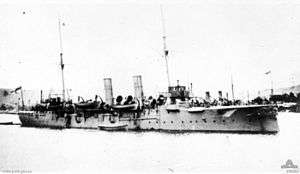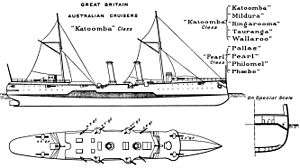HMS Katoomba (1889)
 | |
| History | |
|---|---|
| Name: | Pandora |
| Namesake: | |
| Builder: | Armstrong Whitworth, Elswick, Tyne and Wear |
| Laid down: | 15 August 1888 |
| Launched: | 27 August 1889 |
| Completed: | 1 December 1890 |
| Renamed: | Katoomba |
| Fate: | Sold for scrap, 10 July 1906 |
| General characteristics | |
| Class and type: | Pearl-class cruiser |
| Displacement: | 2,575 tons |
| Length: | |
| Beam: | 41 ft (12 m)[1] |
| Draught: | 15 ft 6 in (4.7 m) |
| Installed power: | |
| Propulsion: | 2 × screws; 2 × 3-cylinder triple-expansion steam engines[1] |
| Speed: | 19 knots (35 km/h; 22 mph) |
| Complement: | 210 |
| Armament: |
|
| Armour: |
|
HMS Katoomba was a Pearl-class cruiser built for the Royal Navy, originally named HMS Pandora, built by Armstrong Whitworth, Elswick, Tyne and Wear and launched on 27 August 1889.[2] Renamed on 2 April 1890, as Katoomba as the flagship of the Auxiliary Squadron of the Australia Station. She arrived in Sydney with the squadron on 5 September 1891. She was damaged in a collision with the tug Yatala in Port Adelaide on 29 December 1891.[3] She left the Australia Station on 16 January 1906. She was sold for £8500 on 10 July 1906 and broken up at Morecambe.[2]

A Pearl-class cruiser from Brassey's Naval Annual, 1897
Notes
References
- Bastock, John (1988). Ships on the Australia Station. Frenchs Forest, Australia: Child & Associates. ISBN 0-86777-348-0.
- Brook, Peter (1999). Warships for Export: Armstrong Warships 1867 – 1927. Gravesend, Kent, UK: World Ship Society. ISBN 0-905617-89-4.
- Winfield, Rif & Lyon, David (2004). The Sail and Steam Navy List: All the Ships of the Royal Navy 1815–1889. London: Chatham Publishing. ISBN 978-1-86176-032-6. OCLC 52620555.
This article is issued from
Wikipedia.
The text is licensed under Creative Commons - Attribution - Sharealike.
Additional terms may apply for the media files.